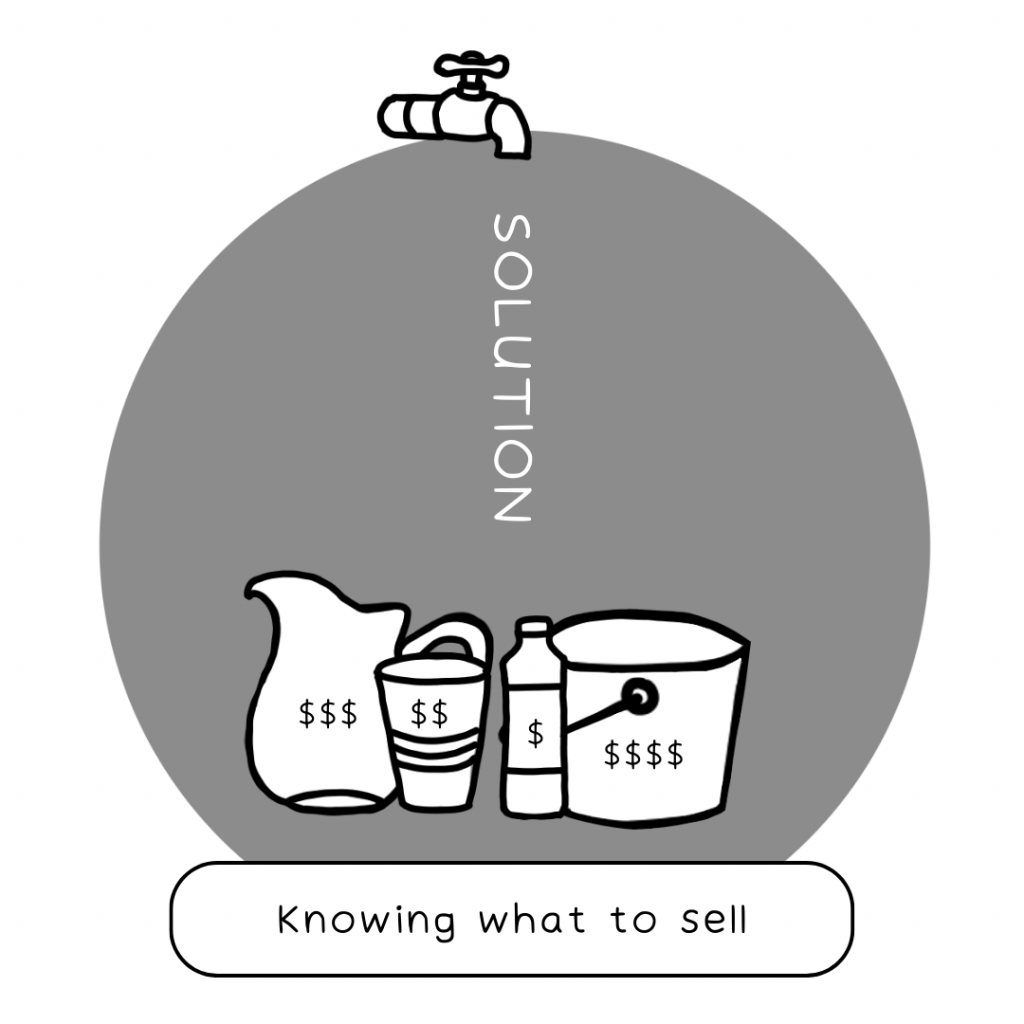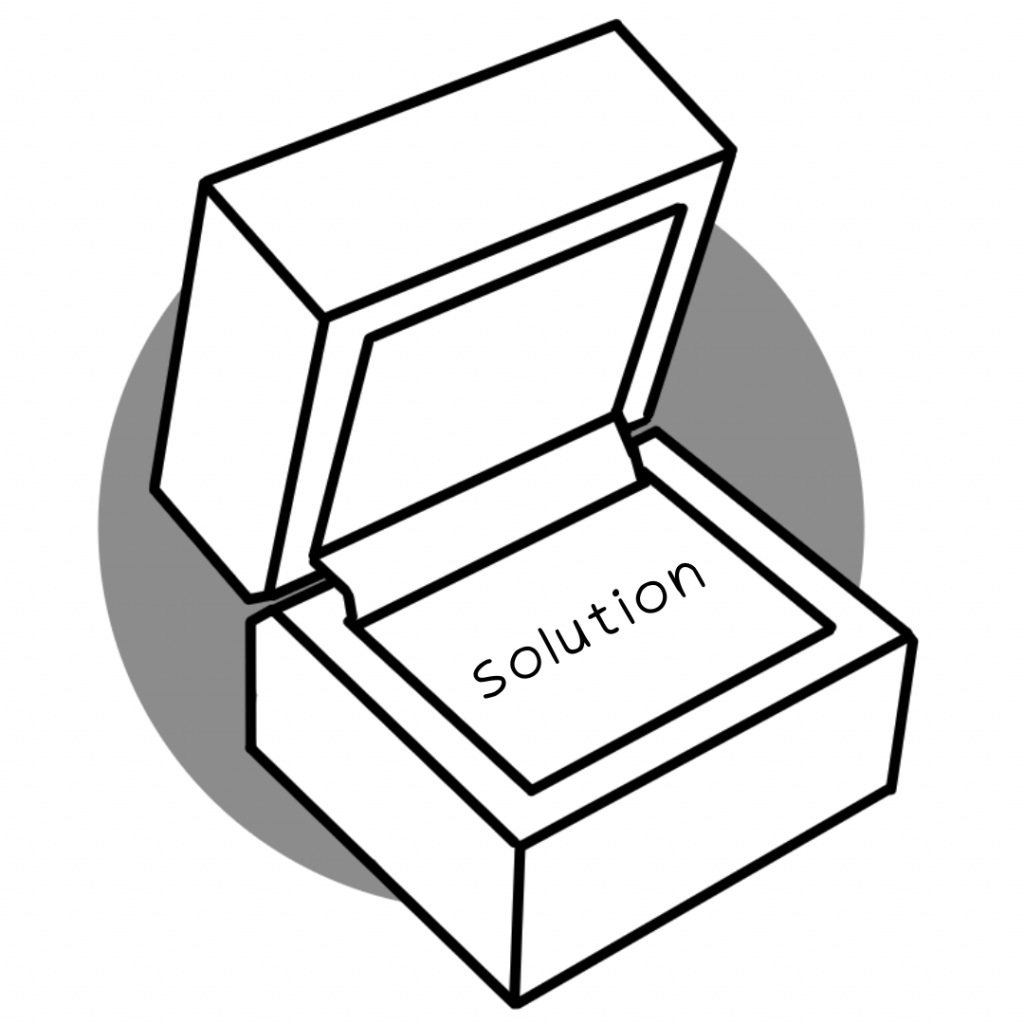Chapter II: Solution Delivery Mechanism
जसले सोलुसन काढ्छ, उसले हात चाट्छ ।
Creating a solution vs. knowing what to sell
The theoretical process of creating a solution is easy:
- Focus on a customer profile.
- State their problem out loud (the more common the problem, the better).
- Come up with a solution for the problem.
But, creating a solution isn’t the same as knowing what to sell.
To know what to sell, you also need to figure out the delivery mechanism for the solution you created.

I do not exaggerate when I say this: knowing what to sell is the missing part of the equation that can turn your rough and ugly looking solution into smooth and beautiful in the eyes of the customer.
Having said that, I must also point out that this is one of the most overlooked details when building a tech service business because there is more to this than what meets the eye.
Why is it important to know what to sell?

Knowing what to sell is one of the most important things a new tech entrepreneur can figure out for their business. It is also one of the hardest things to do.
Whenever you create a solution, you’re building up a belief or in some sense, a ‘hypothesis’ that the customer wants the solution because they have a pre-identified problem.
And, whenever you’re defining the delivery mechanism of your solution, you are making sure that you’re testing out your belief/hypothesis in the best available ways in front of you. This can be better understood with an example:
For a new content writing company, the process of creating a solution may look something like this:
- Target Customer Profile: Online businesses
- Customer Problem: Online businesses want more traffic to their blog from search engine results
- Business Solution: Create SEO-focused articles
Here, the content writing company has a belief that online businesses need SEO-focused articles for their blog because they want more traffic through search engine results.
Now, the company needs to fill in the missing part of the equation to test their belief and make their solution a hit for those online businesses: how do they deliver the solution?
The company may opt for delivering its solution through,
- custom consulting service where the company itself takes on the responsibility of writing every single article based on its customers’ needs on pay-per-word pricing.
- agency service where the company provides SEO-focused content writers to directly work with its customers daily for a fixed monthly fee.
- productized service where customers can buy a custom execution strategy for their online business at a fixed price. The custom strategy is built on top of a general strategy template for creating great SEO-focused articles.
- software-as-a-service where customers can use artificial intelligence (AI) to generate SEO-focused content for their blogs on their own by paying a monthly subscription fee.
You’ll notice that the solution is the same across all the methods mentioned above. Still, the delivery methods are different, which changes the positioning of the content writing company in the market. So, in essence, even if the solution is the same, knowing what to sell defines the trajectory of a business.
Piggybacking on this understanding, we can also conclude that the right selection of a solution delivery mechanism is also dependent on the target market.
For example, in markets like Nepal, delivering the above solution as software-as-a-service may not be the best way for the content writing company to test its hypothesis since the target customer profile (online businesses) is used to paying local content writers for generating content at a low cost.
However, when delivering the same solution in markets like the US, using software-as-a-service as the delivery mechanism may be the best way for the company to test its hypothesis since the target customer profile is most likely to pay a recurring monthly fee for generating content on their own.
This shows that there are three significant foundations to becoming successful at international sales as a tech service business:
- the solution,
- the solution delivery mechanism, and
- the target market you are serving.
While you are responsible for creating your own solution based on the problem you’ve identified, I will be helping you select a solution delivery mechanism that best tests your hypothesis.
What will your solution delivery mechanism be?

So far, you’ve discovered four different solution delivery mechanisms that almost all tech service businesses can use to deliver their solution:
- Custom Consulting Service
- Agency Service
- Productized Service
- As-a-Service Model
I’ll go over each of these in detail to help you understand them better and help you decide on selecting/transitioning to a solution delivery mechanism that best suits your business.
1. Custom Consulting Service
Through custom consulting service, you provide highly customized solutions to clients who have their own set of requirements and, in turn, make all engagements unique to their own.
For example, a business using this solution delivery mechanism may be building a web application for one client while simultaneously building a mobile application for another client.
Here, the client decides the solution they want to build, and the business makes it for them.
As a side note, this is the most common solution delivery mechanism followed by Nepalese tech service companies, where even if the hourly price sheet might be the same across multiple clients, the delivered solutions vary widely from one client to another.
The advantages that come with using this solution delivery mechanism are as follows:
- Getting your business off the ground is easy since you can deliver your solutions as a company even with a limited team size of only 2 people.
- You can start delivering solutions with a small initial investment capital (most likely lower than NPR 1 lakh) since the client typically pays for any resources necessary to complete the solution delivery.
- There is flexibility in pricing according to the client you serve, which means you can charge for the value of the solution (value-based pricing) or the production cost of the solution (cost-based pricing). For example, you can charge for the development of a website based on the number of users it will serve (value-based pricing) or you can charge based on the hours you spend on building the website (cost-based pricing).
- Landing a single high-value client is enough to gain credibility in the custom consulting service market.
- Landing a single high-paying client is enough to sustain your business.
- You can hire both freelancers as well as employees to work on your client’s solution on a per-need basis.
Now to help you think twice about using this solution delivery mechanism, here are some things you should know:
- You may go through a ‘feast or famine’ period where you can only land multiple clients for one part of the year and cannot land any clients for the rest of the year.
- You need both education and experience to effectively pitch and sell a custom solution for a client’s problem.
- Without high-value clients in your portfolio or a track record of delivering high-quality projects, you will have a hard time selling your solution at a premium rate.
- You need to take responsibility for every single detail of the solution delivery process leading you to take on more risk as a tech service provider.
- Unplanned contingencies are common in custom consulting services, making it hard to deliver solutions successfully and on time.
2. Agency Service
In an agency service, you are the supplier, the client is the buyer, and the product you supply is human resources.
This means that you provide the client with a vetted talent such that the client works directly with the designated talent in building a solution, and you take a cut in between for providing the human resource.
For example, a business using this solution delivery mechanism may provide content writers to one client and then provide software developers to another client.
Here, the client decides who to hire to build a solution while the business supplies the required personnel.
The advantages that come with using this solution delivery mechanism are as follows:
- The hired human resource is responsible for communicating and working with the client directly. This allows you to focus on growing your business with a minority of your time spent on project management.
- You can work on a wide variety of tech domains by providing human resources to clients on an as-need basis.
- Figuring out how to source talents quickly from the market allows you to grow your business quickly.
Now to help you think twice about using this solution delivery mechanism, here are some things you should know:
- You need a new human resource for every new client since there is a 1-to-1 relationship between the client and the resource. Agency businesses have a hard time scaling if they cannot find and hire talents to work with their clients.
- If the client ends the engagement mid-way or your business doesn’t land a client, you may be left with the overhead cost of each human resource until they can be engaged in new projects.
- If a talent leaves an engagement before solution delivery, you may have problems quickly filling in their spot, resulting in issues with project delivery timelines.
- If there is a dispute between the client and the talent, you will have a hard time mediating the dispute.
3. Productized Service
In productized service, you sell your service as a customizable product rather than working on custom client requirements. So, clients who purchase a productized service typically want a specific result you guarantee to deliver.
For example, if a business guarantees to generate 10,000 followers for its client’s Twitter account for NPR 1500, that is a real-world representation of a productized service.
Here, the business decides the solution and its price beforehand, and the client agrees to purchase the solution with some customizations if needed.
The advantages that come with using this solution delivery mechanism are as follows:
- Your offering is straight to the point, making it easier to pitch and sell your service.
- You have an easier time onboarding clients and gaining their trust since you possess the expertise in the given productized service.
- You can start delivering solutions with a small initial investment capital (most likely lower than NPR 1 lakh) since the client typically pays for any resources necessary to complete the solution delivery.
Now to help you think twice about using this solution delivery mechanism, here are some things you should know:
- It is hard to charge a premium price for a productized service. Your revenue per client is generally lower than when you perform custom consulting or provide human resources as an agency. For example, a business that charges clients based on the number of Twitter followers they provide will not be able to charge as much as a business that builds a custom social media strategy for its clients.
- It takes a considerable amount of research to know what a large number of clients are looking to buy in the market for a fixed price.
- You need to sell at scale to turn in profits for your business because the business is not fully automated, and there are employee overheads in place.
4. As-a-Service Model
In the as-a-service model, you provide your infrastructure, platform, or software as a service to your clients.
There are three subcategories to an as-a-service model:
a. Infrastructure as a Service (IaaS)
Through IaaS, clients can purchase on-demand cloud-based alternatives to on-premise physical infrastructures for computing power, storage space, etc.
AWS S3 Storage is an example of IaaS since you do not have to worry about the physical hardware required to store files on the cloud, and you can simply upload your files to the internet.
b. Platform as a Service (PaaS)
Through PaaS, clients can purchase the necessary software and hardware resources required to build a solution without knowing the underlying infrastructure’s fundamentals.
Digital Ocean Droplet is an example of PaaS since users can quickly build and deploy a web application within a few clicks.
c. Software as a Service (SaaS)
Through SaaS, clients can purchase ready-to-use software over the internet, usually for a subscription fee or a pay-as-you-use basis.
Salesforce is an example of SaaS since it provides all the features needed to manage the sales department of a business at a set subscription fee.
IaaS, PaaS, and SaaS, or as-a-service model businesses, generally are highly competitive because two similar businesses following the same delivery mechanism have a tough time existing in the same market.
Let’s look at the advantages and things you may need to consider for an as-a-service business model.
The advantages that come with using an as-a-service model solution delivery mechanism are as follows:
- You need to have the know-how to develop such services.
- Your offering is straight to the point, making it easier to pitch and sell your service.
- As-a-service model businesses are easier to sell and exit from as a founder since online marketplaces exist for buying and selling such businesses.
- You can sell the same solution to multiple people over the internet while concentrating on making your service offering the best in class.
- The entire business can be automated to serve multiple clients simultaneously.
Now to help you think twice about using this solution delivery mechanism, here are some things you should know:
- You may need to spend a good amount of time and capital on building an as-a-service business since multiple iterations are required to offer a viable solution with a good user experience.
- You must be cautious of user data privacy and follow strict cyber security practices to avoid data theft.
- You will need to be cautious of client resource usage for your services and should be prepared to scale them as necessary.
- You will need to scale your support team as customers increase. This is often an issue for new businesses without significant investment capital.
By now, you should have a clear understanding of which solution delivery mechanisms might suit your tech service business and which might not.
As you go into defining your target market with high certainty later on in this book through client personas, you will have an even more vivid picture of which solution delivery mechanism to choose for your business.